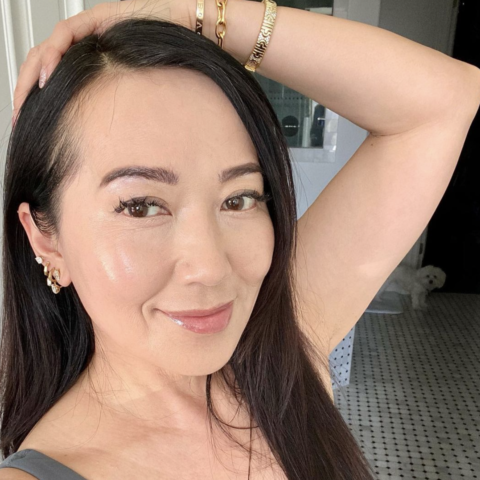Meet Tina Chen Craig (a.k.a. Bag Snob), an OG Fashion Blogger Turned Skincare Brand Founder
"If you’re not a person of Asian descent and you don't credit our culture [with creating certain beauty rituals], you're whitewashing these old traditions and essentially saying 'We can do it better.' That's when it becomes offensive."
When Tina Chen Craig launched her blog Bag Snob with Kelly Cook back in September 2005, she set the wheels in motion to become one of the original fashion bloggers. The bags and accessories blog, of course, took off and later transformed into a multifaceted business that includes advertising, consulting, e-commerce and a handbag line. Today, Craig is the proud founder of another venture that pivots away from fashion — a new luxury skincare line called U Beauty that counts Chiara Ferragni, Nicky Hilton and Joanna Czech as fans.
As part of our series of profiles in celebration of Asian American and Pacific Islander (AAPI) Heritage Month, we caught up with U Beauty founder Tina Chen Craig to chat all things beauty, including how her grandmother shaped her appreciation for skincare.
On her lifelong relationship with beauty
“Beauty was [always] a huge part of my life. My first memories are of my grandmother shoving chicken feet, bone broth, bitter melon and snow fungus in my face for good skin. With Chinese people, it’s all about having good, healthy skin so I wasn’t allowed to wear makeup until I was 17. I would sneak my makeup out of the house, of course. But I was taught beauty starts from the inside — what we ate. My grandmother also taught me about sunscreen, which I rejected as a teenager in the ’80s in California. I was like ‘No, I want baby oil.’ Overall, though, growing up, my relationship with beauty was not about hiding my face or hiding my skin; it was about showing it off. As a college kid, I couldn’t afford the La Prairie eye serums but I’d hang out at Neiman Marcus to get the free samples. I befriended all the people working behind the skincare counters. And then I would watch them eat a grapefruit and put the peel on their face afterward and I always thought that was so embarrassing. My mom would also ferment rice water to make this fermented rice wine dessert with little mochi balls, and then the other half she’d put on her face and her hair. It was with these things that I learned about acids. They were doing an alpha-hydroxy peel with their grapefruits, and getting enzymes from the rice.”
On the influence of her grandmother’s home remedies
“I took the lessons I learned about simplicity with me. My grandmother and my mom didn’t use 50 things. They had a few favourites, like Clinique and Estée Lauder, and that was it. They were very simple.”
On appreciation vs. appropriation in the beauty industry
“There are appropriate ways of highlighting the source of certain practices in the beauty industry, like gua sha and 12-step routines, and that’s by crediting Asian cultures. If you’re not a person of Asian descent and you don’t credit our culture, you’re whitewashing these old traditions and essentially saying ‘We can do it better.’ That’s when it becomes offensive. Another example is cupping. I used to be embarrassed and cover up my [cupping marks] and when I see people [recommending but not mentioning the history of the practice of] cupping now it’s like, ‘Oh my god, that was once my source of shame.”
On launching her new beauty brand, U Beauty
“I never thought I’d launch my own brand. There are so many skincare brands and I was working with some of the top brands in the world like Clé de Peau, Charlotte Tilbury, Augustinus Bader. I’ve always had a deep obsession with skin, which was fuelled by my Chinese grandmother. I was boasting about my 13-step skincare routine before Instagram was even a thing. But after about a decade and a half of doing that, I was like, ‘Holy shit I have cosmetic confusion and so does everybody else.’ I was like ‘Why do I have to put on retinol at night on Mondays, Wednesdays and Fridays, then lactic acid on Tuesdays and Thursdays…and then my face blows up anyway with a rosacea flare-up.’ So I started working with skincare brands that were more minimal, but the next thing you know, they’ve come out with 50 different products they wanted to hire me to talk about. So I set out to really simplify my routine. I only used Aquaphor for two weeks.
“One night I had dinner with an old friend who’s a seasoned beauty brand developer and she said she’d been thinking the same things. She later introduced me to this clinical lab in Italy she’d partnered with. We met and I spent hours talking about my dreams. Instead of saying no, they said ‘Yes, it’s possible, but nobody has wanted to do that because it’s expensive.’ Every brand wants to sell consumers 30 different products, obviously. Like, why would you combine everything? There’s no business plan for that. But we formulated a sample anyway, and that became our proprietary technology. It’s engineered to interact with skin as if it’s an actual skin molecule. So the capsule mimics a healthy skin cell and lures free radicals, which materialize as vulnerable damaged areas in our skin. So when you apply the product, it releases the active ingredients only onto the damaged parts of your face. It interacts with the skin as if it’s an actual healthy skin cell.”
On beauty advice for her younger self
“Lay off the blue eyeshadow and hairspray.”








